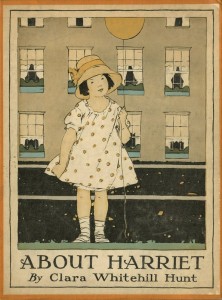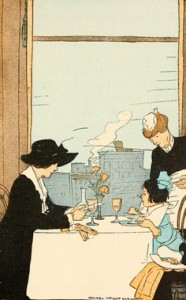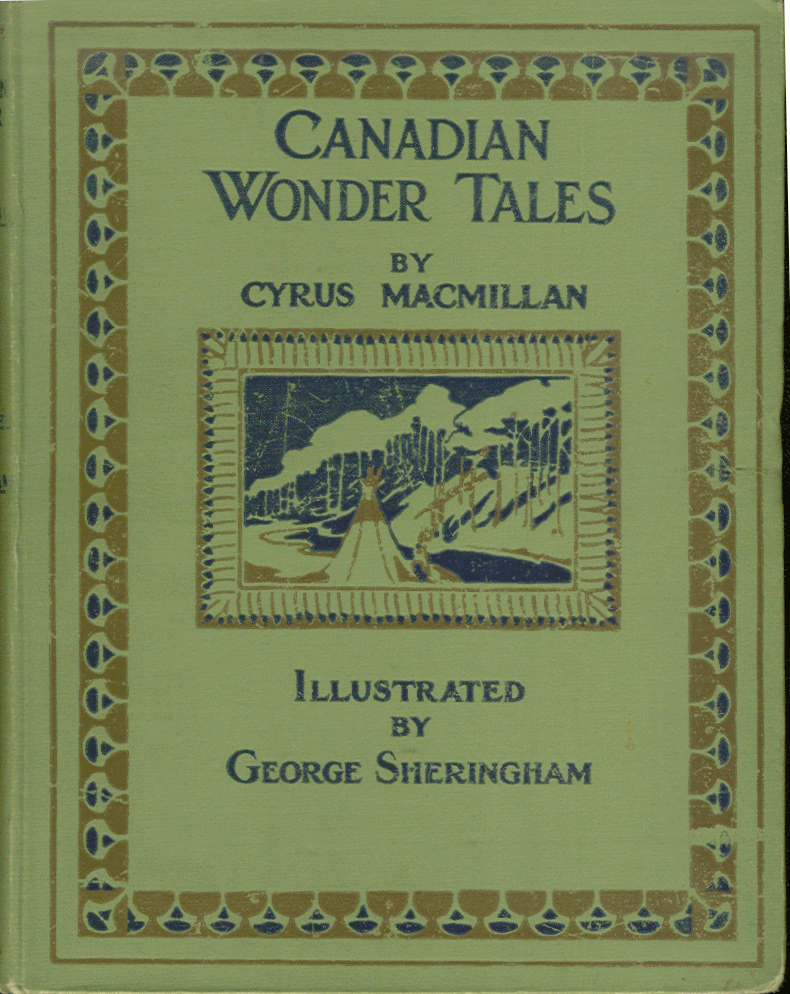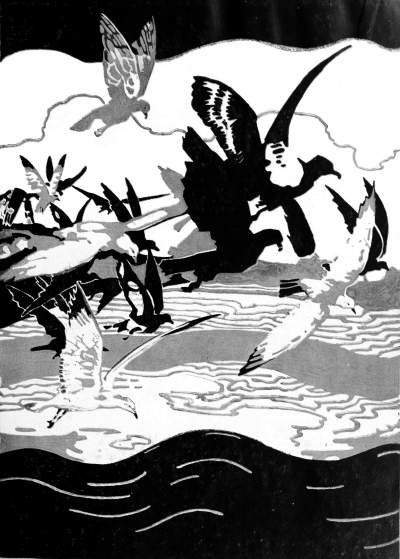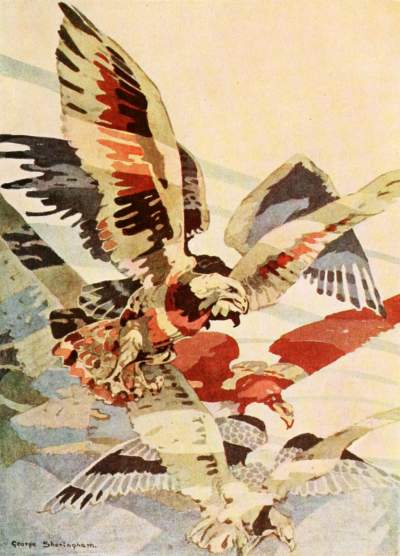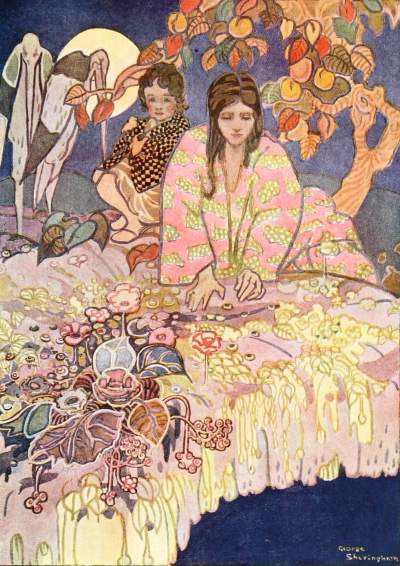© Copyright 2014 Nabila Islam, Ryerson University
Introduction

One popular title under the theme of Children’s Books and War is Rilla of Ingleside. The novel was written by Lucy Maud Montgomery and was published in 1921, after the Great War had ended. Although Montgomery had not written this novel specifically for children, by the 1920s all her books were being marketed for children and they became equally popular for children and adults alike (Rubio, Gift of Wings 289).
This particular copy is located in the Children’s Literature Archive at Ryerson University and was published by Grosset and Dunlap. It does not have the illustrated cover or the frontispiece of the first edition however, there are decorated end pages illustrated by Sheldon. Although this reprint was published in New York, there is a sticker in the book which reads, “711 The Old Corner Book Store, Inc. Boston, – Mass.” indicating that this copy was likely sold by the historic book store. There is also a name, “Jennifer Bevan,” written in pencil, indicating a former owner of this copy.

The novel follows the maturation of Rilla, a native of idyllic Prince Edward Island at the time when WWI shakes Canadian men and women into action. This is one of the few enduring titles of war fiction and it contains a cultural memory of the trauma and horrors Canadian men endured. Through Rilla’s older brothers, Jem and Walter Blythe, aspects of what Anglo-Canadian men faced can be discerned, allowing readers an understanding of WWI.
Summary
This coming-of-age novel opens with the news of the war breaking out in 1914. The 35 chapters focus on Anne and Gilbert’s youngest child, Bertha Marilla Blythe. Rilla is impetuous and oblivious, ready to take part in adult activities. But when WWI occurs, her brothers, friends and beau go off to war and Rilla has to grow up in ways she had not expected. The novel also shows the struggle young men (and their loved ones) had with the ugliness and death associated with war through the characters of Jem and Walter Blythe. These men also had to grow up too fast. They had to kill men like themselves and were unable to forget the aftermath of battles or worse, they never made it back from the battlefields. Through Rilla’s brothers readers understand the desire to fight as well as the desire to avoid the fighting and that the men that returned home were not the same as those who initially left.
Production and Reception
As a novel published after the war had ended, written by the author of the beloved “Anne” and focusing on Anne’s youngest child, this book did not sell as much as Anne of Green Gables did. By 1924 it had only sold 12 000 copies. This could be due to the fact that Montgomery did not give the US much credit in her novel. There are letters from her American publisher Stokes, griping that she had not “taffied up” America enough in her novel (Russell). To this Montgomery stressed that she had written about Canada and the war. Another reason for the poor sales could be that after the Great War came the Great Depression (Mitchell 144) and economic instability led to a decrease in book sales. It should be mentioned that Rilla of Ingleside went on to have various reprints, editions and translations published and that Montgomery herself expected the lesser sales.
Gender Pressure in the Great War
When England called upon Canada, the Anglo-Canadian communities rose up to the challenge. Many young men were anxious to go fight in the war, afraid they would miss out on the fun because the war was not expected to last long. Young women took up the jobs their brothers, fathers and friends left behind so that the country continued to run on a day-to-day basis while the men were away. This arrangement was suitable, at the start. However, many men were killed or maimed. They went missing or taken hostage and the war continued for 4 bitter years.
In this time Lucy Maud Montgomery saw the men in her Leaskdale community off to join the battles, along with her half-brother Hugh Carlyle Montgomery. Like Anne and her daughter Rilla, Montgomery had her ear out for any news of the men she knew, dreading to read a familiar name in the list of those killed in action (Waterston, Magic Island 105). Meanwhile on the battle fields, the men who were unlucky enough to be of age to fight were trying to survive. The pressure to fight and return victorious was strong and works such as Rilla of Ingleside is a way of holding broken spirits together in cultural memory.
The Leaskdale Boys

Montgomery had extensive material to use for this novel stemming from the letters of the young men from her community and from her brother. Robert Brooks, Morley Shier and Goldwin Lapp were from families within the Leaskdale community who were known to Montgomery, or rather Mrs. Macdonald the wife of their minister. There were many reasons for young men to join the war. Appeal of a man’s moral sense through religious analogy of good and evil, a sense of patriotism or of principle, a sense of disgust over stories of atrocities committed against others and for the fun of an adventure were the most common. There was also recruitment through pressure. Whatever their reasons, the Leaskdale boys joined the war through the 256th Royal Air Force Squadron (Brooks), 116th battalion of the 3rd Division of Canadian Corps (Shier) and the 20th Canadian Battalion of the Canadian Expeditionary Force (Lapp) and their letters provided a broad understanding of the war. Yet the tragic details of their service also provided poignant moments in Montgomery’s novel.

In the stories of these young men readers can see Jem Blythe. He joins up right away and fights hard. He goes missing for some agonizing months and when he returns home, he has a limp. A character named for Montgomery’s half-brother Carl loses an eye (Waterston, Magic Island 108). The loss is similar to that actually sustained by Carl, who had returned from Vimy Ridge without part of his leg. In her novel Rainbow Valley, Walter, then a boy, has a premonition of the war (Carvert 20). He says “Jem will want to go – it will be such an adventure – but I won’t. Only I’ll have to…” Before news of Walter’s death reaches the Blythes, Dog Monday howls inconsolably. This detail was replicated from the story of the Lapp’s dog howling all night prior to the telegraph of George Lapp’s death. The novel does not detail actual battles and trench warfare. There is no detailed account in that regard. Yet Montgomery fully conveyed the anguish and dread, the myriad of emotions war generates and the little details that tell the story.
The Piper in Flanders Fields
Montgomery was once presented to the Governor General, Earl Grey (Rubio, Gift of WIngs 136). At this meeting, she would have also been introduced to John McCrae, as he was also attending the event. It is unclear if they interacted beyond this however McCrae was the type of man Montgomery held in high regard. Born in Guelph, McCrae’s family was originally from Scotland and they were devout Presbyterians and his background was a point of connection between the two. John McCrae would have rated himself as soldier first, doctor second and writer third (Granfield 23).
Although he had retired from the military in 1904, he offered himself either as a soldier or doctor for the purposes of the war when the news broke. McCrae was a well-respected surgeon, moving up the ranks over the course of WWI. May 3, 1915, McCrae’s friend Lt. Alexis Helmer was a casualty of war. His death was the inspiration for “In Flanders Fields” which McCrae wrote the very next day. Yet the poem was not published until Dec. 8, 1915, by the British periodical Punch. After which, it exploded across the globe.

Regardless of how much she might have known of McCrae when they met, after the publication of his poem Montgomery would have gained knowledge of his background. McCrae then became the inspiration for her character Water Blythe. In the novel, Walter writes a poem titled “The Piper” which brought him fame similar to McCrae’s “In Flanders Fields.” Walter’s poem was never published in Rilla of Ingleside, although it is later published in The Blythes Are Quoted. McCrae inspires patriotism and an emotional link to the fallen soldiers, as well as referencing to eternal sleep or death through the symbolism of poppies (Waterston, Magic Island 103).

However, Walter’s poem held a slightly different connotation. For Walter the piper’s call was answered by the young Canadians who joined the war front, yet the piper is mysterious and the call is dark and seductive. This piper is referenced in Rainbow Valley. He came in a vision to Walter, where the children followed the piper away from home. The piper inspires courage and his mythical call (the war rhetoric) is met by many young men over the course of WWI (Rubio, Gift of Wings 285). Yet the piper is also a reference to the Pied Piper of Hamelin who led children to their death. Likewise, Walter’s piper is leading these men to their death on battlefields far from home.
Walter’s poem is much darker and fanciful compared to McCrae’s. Perhaps it is because Walter is known to have a sensitive soul and was terrified of joining the war and seeing death’s ugliness for himself. Yet it also shows Montgomery’s own confusion over the war, for as much as the war horrified her with its brutality, she also agreed it was the necessary means to triumph over evil (Rubio, Gift of Wings 286). The duality of the piper creates a rift and obscures Montgomery’s message. Where McCrae writes a call to arms, Walter writes a warning.
The White Feather Brigade
Walter Blythe had faced typhoid prior to the call of war in 1914 and it wasn’t until 1915 that Walter felt strong enough to join the war efforts. However, while he was regaining his strength and pursuing further education at Redmond College, Walter was continuously pressured to join the war. It was there that he was anonymously given a white feather, a symbol of cowardice.

It is believed that this symbolism originates from cockfighting. Birds with white feathers were looked upon unfavourably. People believed the bird would likely lose the fight. However, the white feather also indicated that the bird was not a purebred. By the time WWI began, many people, especially those who were educated, would connect a white feather with cowardice. This is due to literature such as The Four Feathers by A. E. W. Mason (Duffy).
In Britain, Admiral Charles Fitzgerald initiated an “Organisation of the White Feather,” which urged British women to present feathers to able bodied men in hopes of pressuring them into recruitment offices. As popularity grew for this practice, it spread across the oceans. This led to a number of problems as the white feather campaign grew out of hand. By shaming men with these feathers, these female propagandists threatened the ideals of masculinity. The receivers of these feathers did not wish to be looked down upon. They questioned whether they were truly men and these doubts would usually lead them to recruitment houses and battlefields.

Feathers were handed out without thought or sensitivity. They were handed to men who worked for the government, men who were in poor health, men who had returned home on leaves and, most troubling were the feathers handed to boys who were not old enough to join. Some problems were fixed, such as armbands in England that denoted a man was working for his “King and Country” (Hart 2). Other problems were ignored because the need for men in the trenches was great. Enlisting soldiers had to fill out a form called an Attestation Paper (Grandfield), which confirms under oath that the facts given on the form are true; a practice which became a neglected formality as the war went on. Every able body counted, regardless of age or health.
A New World
Montgomery recorded a legitimate fear in her journal on June 17, 1916: “Our old world is passed away forever – and I fear that those of us who have lived half our span therein will never feel wholly at home in the new.” (Montgomery, Selected Journals 186). The white feathers may have made men question their masculinity and measure it by the willingness to fight in war but it was the war that reshaped gender identities. It allowed women to surpass the stigma of the “weaker sex” and the end of WWI did not mean that the women reverted back to their old positions easily. The surviving men came home broken and racked with guilt and often unable to cope with returning to their old lives. Yet Montgomery attempted to hold on to the “old world” in her closing chapter in Rilla of Ingleside. With the return of her beau, Ken Ford, Rilla reverted back to her lisp, a habit she had outgrown during the war. Many feminist critics have railed at this show of retrogression in Rilla’s character. However, the years before writing this novel had been especially hard on Montgomery with a number of deaths, a miscarriage, her husband Ewan’s mental illness and most especially her beloved Frede’s passing. It is to Frede whom she dedicated Rilla and it is likely Montgomery’s yearning for days gone that she has Rilla slip into old habits.
Conclusion
Deep in the roots of this novel there is propaganda present. It’s in the way the women take up the gendered identities of men when a country is left to them. It is in the way young boys like Shirley Blythe want to join in the war. It’s especially in the way Jem and Walter Blythe join silently, with or without facing the shame of the dreadful White Feather and in the way men such as these two fought bravely despite fears and reservations. Montgomery and McCrae bring to mind unspeakable horrors faced and survived. And keep alive a cultural memory of Anglo-Canadians fighting a war for their country and their families.

Visit the catalogue record of Rilla of Ingleside at the Children’s Literature Archive here.
Read an online copy of Rilla of Ingleside on Project Gutenberg here.
Bibliography
“Artillery Heroes at the Front Say ‘Get into a Man’s Uniform.’” n.d. Toronto Public Library. Web. 9 Mar. 2014.
“Canadian Grenadier 245th Guards Overseas Battalion” n.d. Toronto Public Library. Web. 9 Mar. 2014.
Carvert, Mary Beth. “The Very Soul of the Universe Must Ache With Anguish: L.M. Montgomery, Leaskdale, and Loss in The Great War.” The Shining Scroll Dec. 2011: 13–25. Web. 27 Feb. 2014.
Cloutier, Stephen. “The First World War in Canadian Literature.” The Canadian Encyclopedia 2012. Web. 11 Feb. 2014.
Duffy, Michael. “White Feathers.” First World War.com 22 Aug. 2009. Web. 29 Mar. 2014.
Gammel, Irene. Looking for Anne: How Lucy Maud Montgomery Dreamed up a Literary Classic. Toronto: Key Porter Books, 2008. Print.
Granfield, Linda. Remembering John McCrae: Soldier, Doctor, Poet. Toronto: Scholastic Canada, 2009. Print.
Hart, Peter J. “The White Feather Campaign: A Struggle with Masculinity During World War I.” Student Pulse 2.2 (2010): 4. Web. 29 Mar. 2014.
“I Should Go BUT!!! You Are No Exception, Join Now” n.d. Toronto Public Library. Web. 9 Mar. 2014.
“In Flanders’ Fields” 1918. Toronto Public Library. Web. 9 Mar. 2014.
Lechowick, Frank, and Juanita Lechowick. A Collector’s Guide to L.M. Montgomery Firsts. Charlottetown: F. and J. Lechowick, 2009. Print.
Montgomery, Lucy Maud. Rilla of Ingleside. Reprint. New York: Grosset & Dunlap, 1921. Print. Children’s Literature Archive, Ryerson University.
—. The Selected Journals of L. M. Montgomery. Vol 2, 1910-1921. Ed. Mary Rubio and Elizabeth Waterston. Toronto: Oxford University Press, 1988. Print.
Morton, William Lewis. “Canada : World War I.” Encyclopedia Britannica 2014. Web. 11 Feb. 2014.
Rev. of Rlla of Ingleside, by Lucy Maud Montgomery. New York Times Book Review and Magazine 11 Sept. 1921: 31. Web. 27 Feb. 2014.
Rubio, Mary. Lucy Maud Montgomery: The Gift of Wings. Toronto: Doubleday Canada, 2008. Print.
Russell, Ruth Weber. Lucy Maud Montgomery, a Preliminary Bibliography. Waterloo: University of Waterloo Library, 1986. Print. UW Library Bibliography no. 13.
Waterston, Elizabeth. “Rilla of Ingleside.” Magic Island: The Fictions of L.M. Montgomery. Ontario: Oxford University Press, 2008. 103–111. Print.
“Your Chums Are Fighting. Why Aren’t You?” n.d. Toronto Public Library. Web. 9 Mar. 2014.















